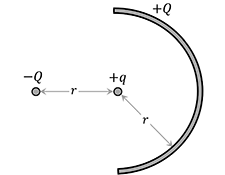
Charge
Variant i Dynamics first Other Variants Interactive tutorial lecture
An introduction to electrostatics that includes: the number and types of charge, charge distributions on conductors and polarization, Newton's third law, and vector superposition.
Topics Electricity and magnetism / Electrostatics: models, representations, symmetry, vectors, and point charges
Materials
Materials by the UW team
- Instructor Guide


- Pretest


- Exam Questions



- Equipment List

Tutorial details
Students begin the tutorial by charging pieces of tape and comparing the interactions of tapes that have been charged in two different ways. They are asked to discuss how their observations are consistent with the idea that there are two different types of charge. At this point, students are asked to check their answers with a tutorial instructor. Often students have difficulty in distinguishing between what they know because they have been told and what they have evidence for. Ask them to assume that they do not know how charges behave and to explain how they would decide on the basis of their experimental results.
In section II of the tutorial, students use Coulomb’s law and Newton’s third law to compare forces exerted on various point charges. Students begin by considering a pair of point charges, and then use the principle of superposition to compare net forces for various arrangements of two, three, and four point charges. In part C of section II, most groups of students can successfully analyze and rank cases A, B, and C, but need help with case D because of the more complicated geometrical reasoning required. Some students need to be asked explicitly to make a judgment about the size of the angle in the picture, which is between 60 and 90 degrees. An estimate of this angle is an essential piece of the reasoning required to rank case D with the other three cases.
In the third section of the tutorial, students use a pith ball and acrylic rods to analyze the force on a pith ball by extended charge distributions. Students consider a case in which two charged rods are held side by side, and a charged pith ball is held next to one of the rods. They are asked whether the rod farther from the pith ball exerts an electric force on it. Many students have the incorrect idea that the force by the farther rod is “blocked” by the closer one. It is important that students be led to confront and resolve their incorrect ideas about superposition before moving on to later tutorials in which they consider more complex charge distributions such as parallel sheets of charge.
The fourth part of the tutorial helps students to account for the attraction between a charged and an uncharged object. They start by considering whether a charged object will attract or repel a ball that is oppositely charged on each of its halves. Many students believe that since the ball has zero net charge, there will be neither attraction nor repulsion. Through discussions with one another and with tutorial instructors, they come to recognize that they must consider the interaction of each piece of the ball with the charged object and then add the effects. Students can then discuss how they might account for the attraction between an uncharged object and a charged object.
For instruction tips, login or register as a verified educator to see the Instructor Guide.
Prerequisites
Prerequisite tutorials
The Forces and Newton's second and third laws tutorials are prerequisites to Charge.
Other prerequisites
Facility with free-body diagrams, including a solid understanding of Newton’s second and third laws, is essential. Familiarity with Coulomb’s law is not required.
Equipment
Special Instructions
Extra pith balls should be available. Plastic rods should be clean and dry. Handling by students can leave oils on the rods.
The experiments in this tutorial are more reliable in dry weather conditions. Students should be encouraged to recharge their pieces of tape, rods, etc., regularly and may need to repeat experiments several times in order to obtain consistent results. It may be necessary to wash rods and other equipment before tutorial with soap to remove oils. Students should be told to handle equipment as little as possible.
List
- fur or cloth (for charging rods)
- plastic rods (approx. ~ 0.5" diameter by 10" long)
- white board or large sheet of paper with markers
- Scotch Magic Tape®
- stands with wood dowels to support the tapes
- pith ball [small Styrofoam balls (~ 1 cm diameter) covered with aluminum foil and hung from fine insulating (e.g.
- polyester) thread]
Coming Soon! We hope to release the discussion section on each tutorial soon.

